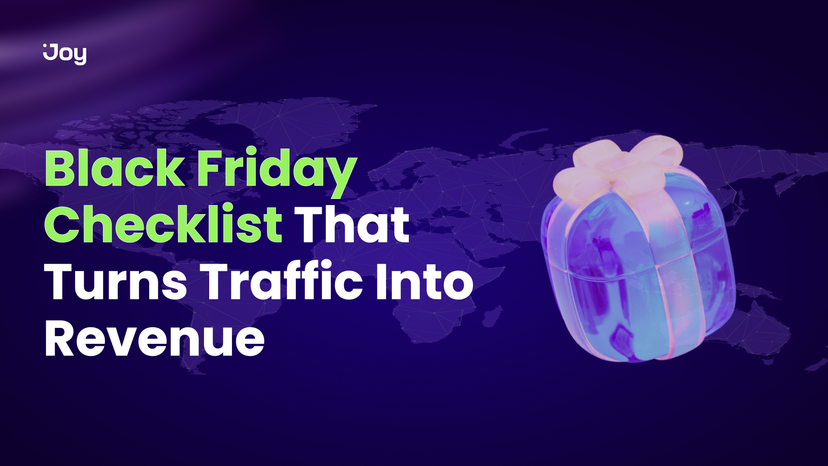Loyalty programs have long been a favorite tool for businesses to keep customers coming back, but recently, a new trend has taken center stage: paid loyalty programs. Unlike traditional models, these programs ask customers to invest upfront—and surprisingly, it’s working!
Why are customers willing to pay for loyalty? What’s driving brands to adopt this approach?
In this article, we’ll dive into the rising popularity of paid loyalty programs and explore how they’re transforming the way companies connect with their most valued customers.
Let’s go!
What Are Paid Loyalty Programs?

Paid loyalty programs, also known as subscription loyalty programs, are a type of loyalty program where customers pay a recurring fee in exchange for exclusive perks and benefits.
This type of loyalty program stands out with its key characteristics:
- Recurring Membership Fee: Customers pay a recurring fee to maintain their membership and continue accessing the program’s benefits.
- Exclusive Benefits: Members receive a range of exclusive benefits that are not available to non-members, such as free shipping, discounts, early product access, or premium customer support.
- High Perceived Value: The rewards in paid programs are intentionally designed to outweigh the cost of membership, making customers feel they’re getting a great deal.
- Increased Customer Commitment: By investing money upfront, customers are more likely to stay loyal to the brand to make the most of their membership benefits.
Paid Loyalty Program vs Traditional Free Program
Both paid and traditional free loyalty programs share the goal of building customer loyalty, but their distinct approaches and value propositions set them apart in impactful ways.
| Aspect | Paid Loyalty Program | Traditional Free Program |
| Membership fee | Requires a recurring fee (monthly/annual) | Free to join |
| Benefits accessibility | Immediate access to premium perks | Benefits earned over time through activity |
| Customer commitment | High (due to paid investment) | Moderate to low |
| Target audience | Customers willing to pay for exclusive benefits | General audience |
| Revenue model | Recurring revenue from membership fees | Revenue generated indirectly via sales |
| Personalization | Often highly personalized rewards | Limited or generalized rewards |
| Engagement level | Typically higher due to perceived value | Varies; engagement depends on interest |
| Value perception | High; perceived as premium | Moderate; depends on points/reward structure |
Why Paid Loyalty Programs Are Getting So Popular
Psychological factors:
- Certain commitment and engagement: When customers pay for a loyalty program, they are more likely to engage with the brand to justify their investment.
A 2020 McKinsey survey found that members of paid loyalty programs are 60% more likely to spend more on the brand after subscribing, compared to a 30% increase for free loyalty programs. - Sunk cost effect: Consumers expect substantial returns on their subscription fees through exclusive rewards and benefits. They anticipate service and exclusivity commensurate with their investment.
According to Forbes, 79% of consumers say loyalty programs make them more likely to continue doing business with brands. - Trust in premium quality: A paid program signals higher quality or superior value. Customers often perceive brands offering paid loyalty programs as more reliable or premium.
Business Advantages:
- Recurring revenue generation: Paid loyalty programs provide businesses with a steady stream of recurring revenue through membership fees. This financial predictability supports sustainable growth and strategic planning.
In 2019, consumers spent an estimated $25 billion to $30 billion on paid loyalty programs, reflecting a 25% to 50% growth rate from the previous year. - Building a loyal customer base: Customers who invest in paid loyalty programs tend to exhibit higher purchase frequency, larger basket sizes, and stronger brand affinity.
BusinessDasher indicates that loyalty program members are 59% more likely to choose a brand over a competitor. - Data insights from dedicated members: Engaged members of paid programs provide valuable data on purchasing behaviors and preferences, helping businesses tailor offerings and optimize marketing strategies.
Personalization efforts can lead to a 6.4x lift in member satisfaction with the loyalty program.
5 Best Paid Loyalty Programs Examples
Amazon Prime
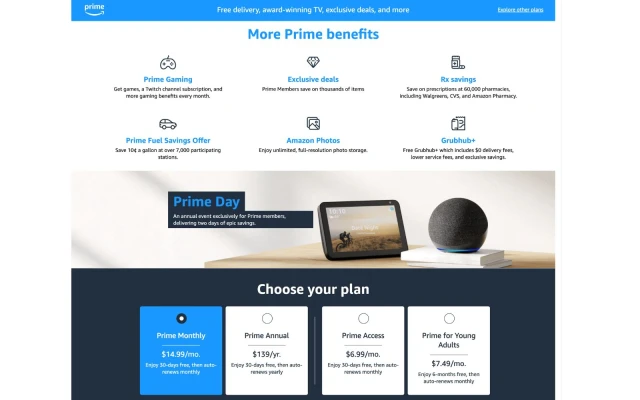
Amazon Prime, launched in 2005, is a subscription-based service that has become a cornerstone of Amazon’s business model. With over 200 million subscribers worldwide, Prime offers members a suite of benefits designed to enhance the shopping and entertainment experience.
Membership benefits and fees:
- Fees: In the U.S., Amazon Prime membership costs $14.99 per month or $139 per year, with discounted rates available for students and eligible government assistance recipients
- Benefits:
- Fast and free shipping
- Prime video
- Prime music
- Prime reading
- Prime gaming:
- Unlimited photo storage with Amazon Photos.
- arly access to Lightning Deals and exclusive promotions.
Unique strategies:
- Comprehensive ecosystem: Amazon Prime integrates shopping, entertainment, and services, creating a one-stop platform that caters to diverse customer needs.
- Customer-centric innovation: Amazon’s relentless focus on customer satisfaction drives continuous enhancement of Prime benefits, ensuring the service remains valuable and relevant.
Why it’s successful:
- The convenience and value offered by Prime encourage repeat purchases and deeper engagement with Amazon’s ecosystem.
- Subscription fees provide a steady revenue stream, while Prime members tend to spend more than non-members, boosting overall sales.
- The extensive range of benefits makes Amazon Prime a unique offering in the market.
Swarovski Crystal Society

The Swarovski Crystal Society (SCS) is a prestigious membership program designed for enthusiasts and collectors of Swarovski’s exquisite crystal creations. With a global community exceeding 300,000 members, SCS offers exclusive access to limited-edition pieces and a range of special benefits.
Membership benefits and fees:
- Fees: Prospective members can choose between a 1-year membership priced at $59 or a 3-year membership at $159.
- Benefits
- Access to limited SCS Annual Editions and Member Exclusives unique pieces not available to the general public.
- Annual gift
- Free shipping
- Invitations to exclusive events
- One free annual visit to Swarovski Kristallwelten in Austria, including a complimentary drink in the VIP lounge.
Unique strategies:
- Collector’s focus: SCS caters specifically to crystal collectors, offering limited-edition pieces that enhance the exclusivity and appeal of the program.
- Global community: With a membership exceeding 300,000 worldwide, SCS fosters a sense of belonging among crystal enthusiasts
- Heritage and craftsmanship: By emphasizing Swarovski’s rich history and commitment to quality, SCS reinforces the brand’s position as a leader in crystal artistry.
Why it’s successful:
- Offer tangible value to its members.
- Focusing on the specific interests of crystal collectors and enthusiasts, SCS creates a tailored experience
- The program’s longevity and substantial global membership are testaments to its effectiveness in building and maintaining a dedicated customer base.
My Best Buy
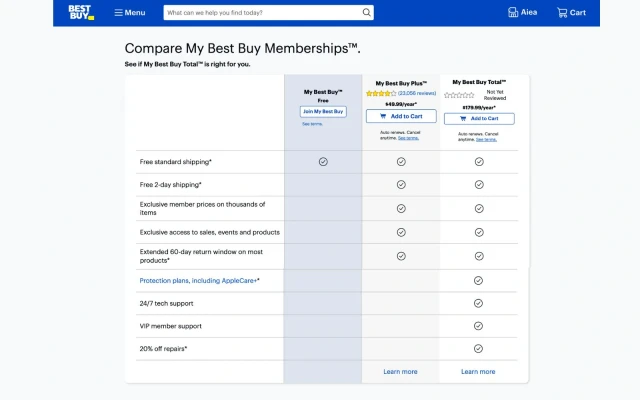
The My Best Buy program is a customer loyalty initiative designed for electronics and tech enthusiasts. With its focus on personalized services and valuable member rewards, My Best Buy has attracted millions of loyal customers, enhancing both engagement and sales for the retailer.
Membership benefits and fees:
- Fees: The program launches a tiered membership structure with a price range from $0 to $179.9 per year with escalating benefits.
- Benefits:
- Free standard shipping
- Exclusive pricing and early access.
- Extended return window on most items
- Higher-tier members receive 24/7 tech support and the option for extended protection plans on select products.
- Priority customer service, streamlining their support experience.
Unique strategies:
- Tiered membership structure: By offering multiple tiers, Best Buy caters to a wide range of customer needs, from casual shoppers to tech enthusiasts.
- Comprehensive protection plans: The inclusion of protection plans, such as AppleCare+, adds significant value, especially for customers investing in high-end electronics.
- Integration with the Best Buy credit card: Members can earn 5% back in rewards or choose flexible financing.
Success factors:
- The program’s structure encourages repeat purchases and deeper engagement
- By bundling services like tech support and product protection, Best Buy differentiates itself in the competitive electronics retail market.
- The annual fees from paid tiers contribute to recurring revenue, while the added services promote higher spending per customer.
REI Co-op
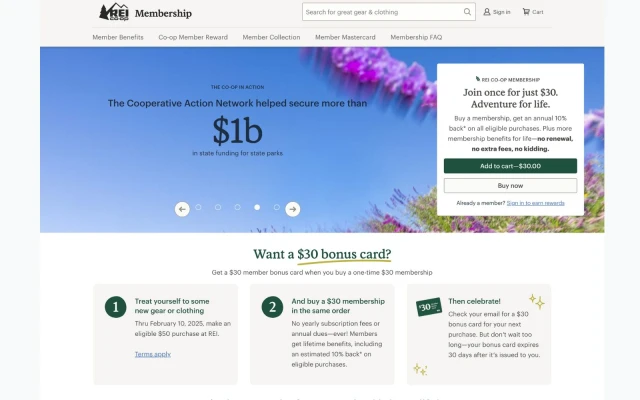
REI Co-op is a renowned long-life outdoor retailer committed to inspiring, educating, and outfitting people for a lifetime of outdoor adventure and stewardship. The REI Co-op Membership is a lifetime membership program designed to offer members exclusive benefits, rewards, and a sense of community among outdoor enthusiasts.
Membership Benefits and Fees:
- Fee: A one-time payment of $30 grants lifetime membership with no renewal fees.
- Benefits:
- Members receive an estimated 10% back on eligible purchases at the end of each year.
- An extended one-year satisfaction guarantee on most items.
- Free standard shipping
- Access to exclusive discounts, special offers, and member-only coupons.
- Re/Supply Program
- access to in-store workshops, presentations, and local events hosted by REI experts and community partners.
- Voting on candidates for the co-op board
Unique strategies:
- Cooperative structure: As a co-op, REI operates for the benefit of its members, reinvesting profits into business and community initiatives.
- Sustainability commitment: REI emphasizes environmental stewardship through programs like Re/Supply and investments in conservation efforts
- Community engagement: The co-op fosters a strong sense of community by offering classes, events, and voting rights.
Why it’s successful:
- Its comprehensive benefits cater to outdoor enthusiasts’ needs and values.
- The lifetime membership fee is a one-time investment, making it accessible and appealing.
- REI’s commitment to sustainability and community engagement resonates with members, fostering a strong, loyal customer base.
SAVAGE X FENTY Rewards Membership
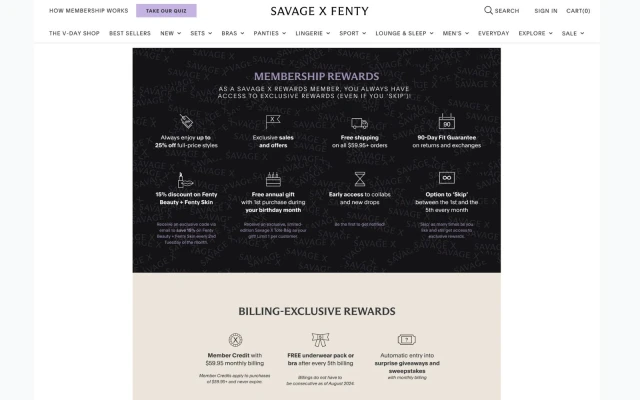
SAVAGE X FENTY is a lingerie brand celebrated for its inclusivity and diverse range of intimate apparel. The SAVAGE X FENTY Rewards Membership is a tiered program designed to offer members exclusive benefits, discounts, and personalized shopping experiences.
Membership Benefits and Fees:
- Fee: Members pay a monthly fee of $59.95, which can be skipped between the 1st and 5th of each month to avoid charges.
- Benefits:
- Each month, members receive a $59.95 credit.
- Exclusive discounts of up to 25% on full-price styles and access to members-only sales.
- Annual rewards:
- Unlimited free shipping and returns
- Surprise giveaways
- Complimentary products
Unique strategies:
- Flexible membership options: The program offers monthly and annual membership tiers, allowing members to choose the plan that best suits their needs.
- Personalized shopping experience: Members receive handpicked monthly selections at discounted prices
- Inclusive brand philosophy: SAVAGE X FENTY promotes body positivity and inclusivity, offering a wide range of sizes and styles to cater to diverse customers.
Why it’s successful:
- The monthly fee is offset by the substantial member credit and exclusive discounts, making it a cost-effective option for regular shoppers.
- Members benefit from early access to new products, surprise giveaways, and complimentary items.
- The brand’s commitment to inclusivity and diversity resonates with a broad customer base.
When Does A Paid Loyalty Program Work For Your Brand

A paid loyalty program can significantly benefit your brand, but it’s not suitable for every business. The decision to implement such a program should be based on the nature of your business.
Below are key factors to consider:
- Strong customer base with consistent spending habits: If your customers already have strong engagement with your products or services and are willing to invest in premium benefits, a paid model can drive deeper loyalty and repeat sales.
- High-value perks and exclusive benefits: If your brand can offer exclusive products, services, or experiences that align with customer desires, a paid program can effectively work.
- Long-term customer relationship focus: This type is a better fit for long-term relationships rather than short-term transactional interactions, which encourage customers to make sustained investments. leading to a stronger customer base.
- Ability to collect and utilize data: Paid programs can help brands gain deeper insights into customer preferences and behaviors, which can be used to tailor marketing and product offerings
- Aligned with business model: They are best suited for businesses with products or services that have high customer lifetime value (CLV). Industries like retail, travel, and entertainment, where repeat engagement is vital, tend to see better results.
How To Set the Subscription Price For Your Paid Loyalty Program
Setting the right subscription price for your paid loyalty program is crucial for attracting customers while ensuring profitability. It requires a balanced approach between your goals and customers’ expectations.
Take a look at a concise process to set up an effective price:
1. Assess program value:
- Determine the value of the program’s benefits (exclusive discounts, free shipping, etc.) and ensure the subscription fee matches the perceived worth.
- Research competitors’ pricing to stay competitive.
2. Know your customers:
- Understand your target audience’s spending capacity (Spending habits. perceived value of rewards, willingness to pay for exclusive benefits)
- Use psychological pricing strategies (e.g., $49.99 instead of $50) to appeal to customers.
3. Factor in costs:
- Ensure the subscription price covers all operational costs (rewards, perks, shipping) and leaves room for profit.
- Account for marketing and administrative expenses.
4. Consider tiered pricing:
- Offer multiple subscription levels (e.g., monthly, annual) for varying customer segments.
- Provide added benefits at higher tiers for more engagement.
5. Test with customers:
- Run pilot programs or surveys to test customer willingness to pay.
- Use A/B testing to determine the best price point.
6. Tracking:
- Track program performance. Adjust the price if engagement is low or if market conditions change.
Key Considerations for Paid Loyalty Programs: Expert Tips
To get the optimal results, here are some expert tips you should take note
- Brand Alignment: Ensure your paid loyalty program reflects your brand’s values, mission, and customer expectations. The perks offered should resonate with your audience and align with your brand identity. (e.g: sustainability, organic, luxury, etc.)
- Exclusivity: Offer rewards and experiences that cannot be easily accessed elsewhere. This could include early product access, personalized services, or unique members-only offers.
- Community building: Consider building a community around the program by hosting exclusive events, offering social media engagement opportunities, or allowing members to share their experiences.
- Communication: Regularly update members on their benefits, program changes, and exclusive offers. Ensure the sign-up process is simple and transparent, with clear explanations of the value proposition.
- Legal and ethical considerations: Be transparent about membership fees, terms, and conditions. Protect customer data in accordance with privacy regulations like GDPR, and avoid deceptive marketing practices. Ethical considerations, such as offering equal access to all customers, are crucial for maintaining trust.
Bottom Line
A paid loyalty program is actually a strategic weapon to transform customers into brand advocates. With the right mix of exclusivity, value, and communication, your program can drive loyalty, boost revenue, and create a passionate community.
When done right, it’s not just a reward for customers—it’s an investment that pays off for your brand in the long run. Don’t just build a program; build a movement!
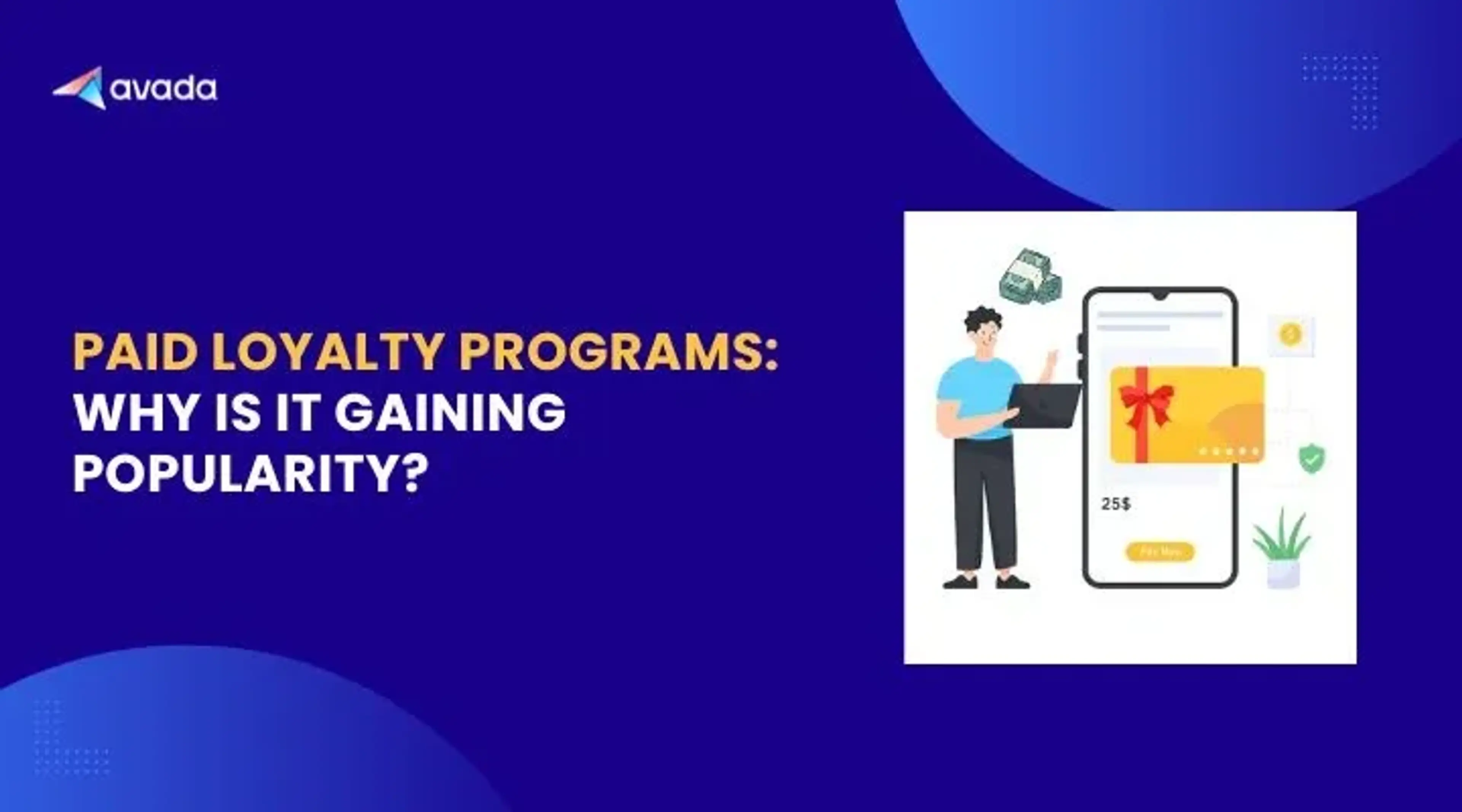


-a7e9a3.png?width=828&q=75&f=webp&auto=format)
